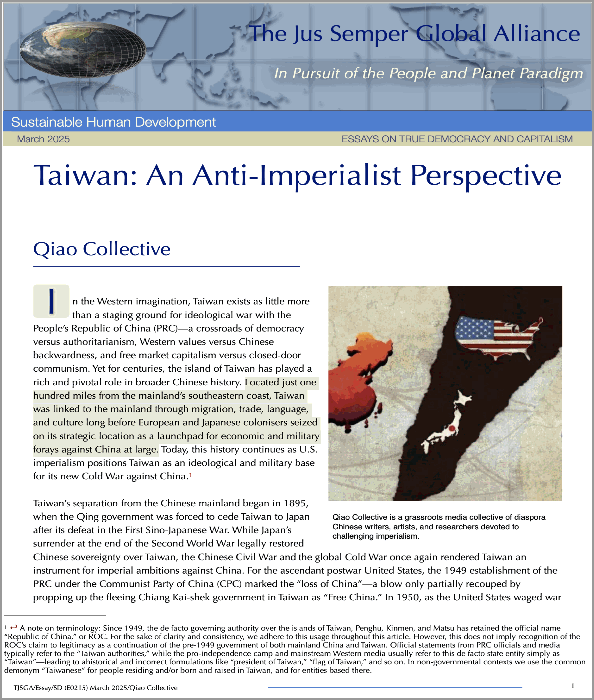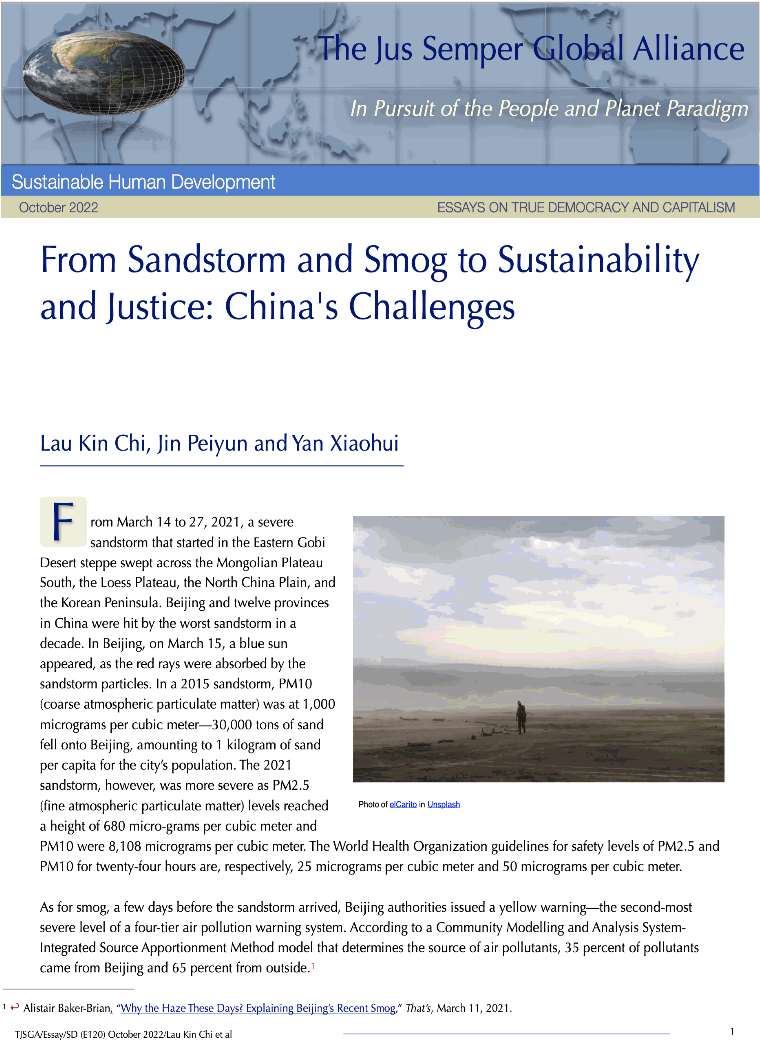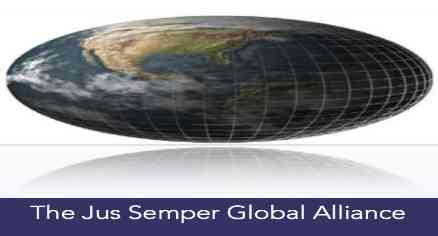Lau Kin Chi, Jin Peiyun and Yan Xiaohui From March 14 to 27, 2021, a severe sandstorm that started in the Eastern Gobi Desert steppe swept across the Mongolian Plateau South, the Loess Plateau, the North China Plain, and the Korean Peninsula. Beijing and twelve provinces in China were hit by the worst sandstorm in a decade. In Beijing, on March 15, a blue sun appeared, as the red rays were absorbed by the sandstorm particles. In a 2015 sandstorm, PM10 (coarse atmospheric particulate matter) was at 1,000 micrograms per cubic meter—30,000 tons of sand fell onto Beijing, amounting to 1 kilogram of sand per capita for the city’s population. The 2021 sandstorm, however, was more severe as PM2.5 (fine atmospheric particulate matter) levels reacheda height of 680 micro-grams per cubic meter and PM10 were 8,108 micrograms per cubic meter. The World Health Organization guidelines for safety levels of PM2.5 and PM10 for twenty-four hours are, respectively, 25 micrograms per cubic meter and 50 micrograms per cubic meter. As for smog, a few days before the sandstorm arrived, Beijing authorities issued a yellow warning—the second-most severe level of a four-tier air pollution warning system. According to a Community Modelling and Analysis System-Integrated Source Apportionment Method model that determines the source of air pollutants, 35 percent of pollutants came from Beijing and 65 percent from outside. The approach to climate change and the mainstream “remedies” pro-posed require serious attention. As Gustavo Esteva has noted, the terms climate change or global warming are too mild to have a strong impact on general perception. The term climate collapse is a much more accurate rendering of the immense challenge for the whole of humanity. However, in the mainstream, the symptoms may be dealt with, but the fundamental problem is not. As in the case of the disposal of radioactive water in Fukushima, which certainly deserves concern, the fundamental question to be asked is how to stop more contaminated water from being generated, so the limelight needs to fall on the molten nuclear mass inside the reactors. In the same manner, the solution is not setting carbon-emission trading quotas, because this presumes emission can continue after purchasing a quota; business as usual. In the same manner, the crucial question is not to choose between fossil fuel or renewable energy, but to interrogate the paradigm that consumes so much energy. Thus, the entire paradigm of modernisation and development as we know it, which has persisted for over two centuries, needs to be interrogated and radically changed. We cannot have business as usual, or lifestyle as usual for the elites, and suffering and sacrifice as usual for the subaltern. China, given the scale of its problems as well as the scale of its population, economy, and resources, is in a position to make a significant contribution to a turn in the trajectory for humanity—this century may see catastrophic consequences for life on earth, including humans, if we cannot avoid a global warming of 2 degrees Celsius. Thus, while there are proposals for remedial measures, these may be futile if some key orientations are not pursued. In 2020, despite the global pandemic, China’s total input and output value was ¥32.1557 trillion ($4.93 trillion), an increase of 1.9 percent over 2019. With the sanctions and hostilities from the United States and its allies in the unfolding of a New Cold War, China, in May 2020, pronounced a “dual circulation strategy,” which essentially means readjustment of its four-decade-long strategy of integration into the global economy since 1978, which was to contribute massive human and environmental “resources” to support an export-oriented economy. The term dual circulation strategy, apparently giving equal importance to the two strategies, in essence means adding “domestic circulation” to the four-decade-long prominence of “external circulation.” However, if this strategy of turning inward is compelled by hostilities and instabilities in the external world, it would vacillate depending on external factors. It does not necessarily mean a self-chosen turn to self-reliance, self-sufficiency, and a proactive path of “delinking” from the impositions of the United States and its allies. If the shift is to be made toward “internal circulation” based on “delinking” from the hegemony and impositions of the United States and its allies, a major reversal of the four decades of export-oriented economic development will need to be carried out. For China and the semi-peripheral and peripheral countries to pursue a path of autonomy and delinking from the U.S.-dominated capitalism, and capitalism itself, radical alternative approaches could and should be con-templated. COVID-19 with its ghastly impacts was unthinkable before December 2019. If over 90 percent of airplanes can be grounded, if extensive human activities can be suspended under lockdowns, though involuntarily, it is also possible to take a path of active (not passive) individual, collective, and systemic changes to meet the challenges of climate collapse.
For a full read of this essay, click here or on the picture to download the pdf file.
|

- © The Jus Semper Global Alliance
| Home |  | Resources |  | Economic Data |  | From Sandstorm and Smog to Sustainability and Justice: China's Challenges |


